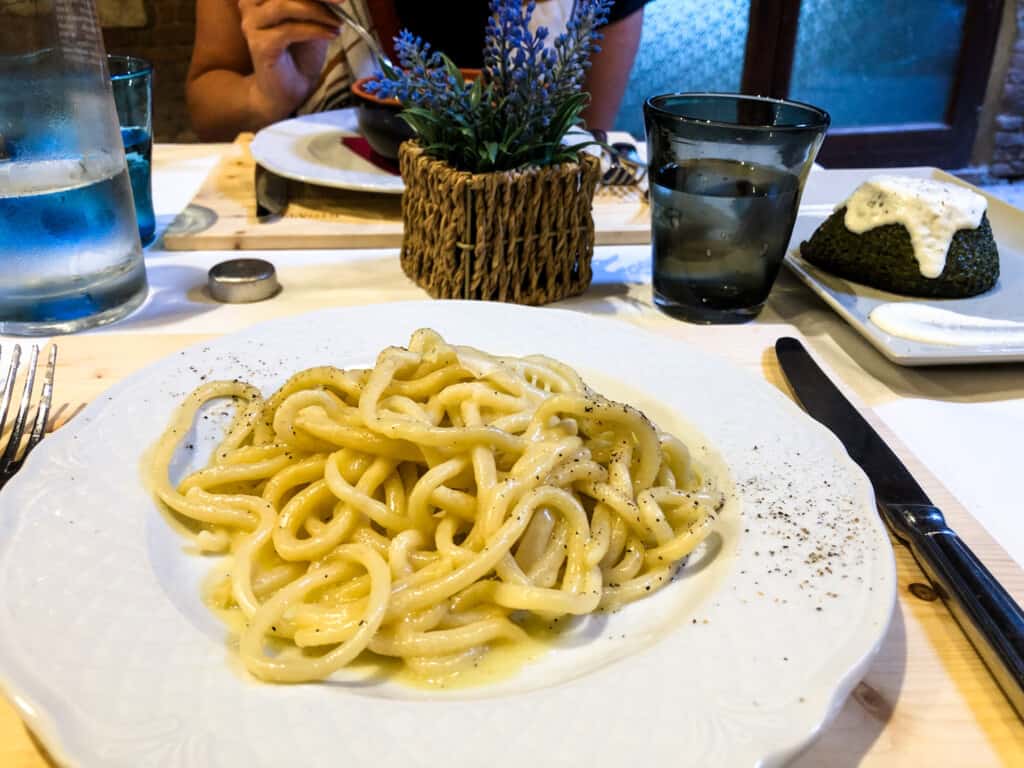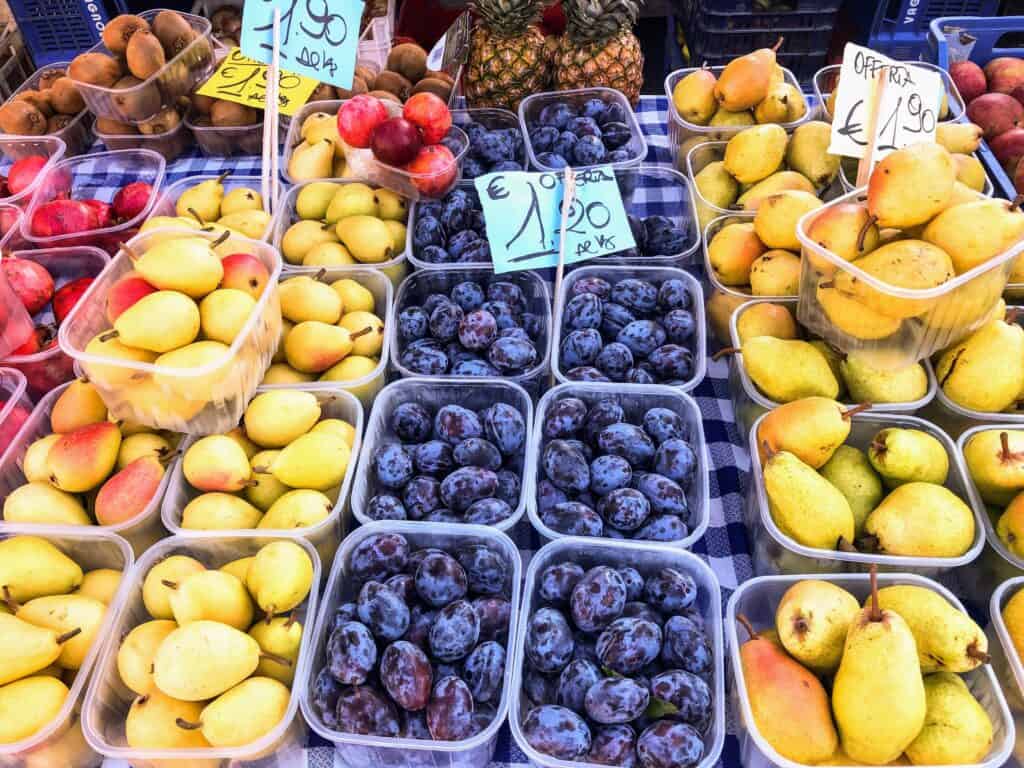Last updated on July 12th, 2023
Are you looking for an authentic chicken cacciatore recipe? Look no further!
Below are step-by-step instructions on how to make my Tuscan family’s recipe for a very traditional pollo alla cacciatore (chicken cacciatore) – the real Italian way, how we make it here.
The recipe for chicken cacciatore evolved as it moved to the United States with Italian immigrants. If you live in the US, you probably know chicken cacciatore as a spicy chicken dish cooked with tomatoes and mushrooms, sometimes served over egg noodles. Authentic chicken cacciatore is far from that!
Pollo alla cacciatore, as it is called in Italian, is a dish that takes a slightly different shape depending on what Italian region you are in (and which grandma is cooking it!). Some families add locally grown olives, other add anchovies, and some stick to traditional methods of preparation. For example, Romans make an in bianco version (a white version) made with white wine and vinegar instead of tomatoes.
Here in Tuscany, we’re chicken cacciatore purists. Tuscans love tradition and they aren’t big on change, so their version is very minimalist – in the very best way possible. This authentic chicken cacciatore recipe comes from my in-laws and showcases the beauty and simplicity of local ingredients and farm-raised chicken.
Read more about Traditional Tuscan Food.
Jump to Section
Pollo alla Cacciatore Pronunciation

Chicken cacciatore in Italian is called pollo alla cacciatore, pronounced poh-loh ahl-lah kahch-chah-TOH-reh.
Listen to the pronunciation of pollo alla cacciatore:
What is Pollo alla Cacciatore?
Pollo alla cacciatore is a chicken stew made from whole chicken pieces that are browned and then simmered slowly with red wine, tomatoes, carrots, onion, celery and garlic. Plenty of herbs are added for depth and warmth.
Although common throughout Italy, this traditional chicken cacciatore recipe is most popular in the central regions of Italy – Tuscany, Umbria and Marche – where red wine and herbs are commonly used to stew meat.
The dish’s name is most likely attributed to the fact that alla cacciatore refers to the garlic and rosemary used in the recipe. Any recipe alla cacciatore will include these ingredients and most likely comes from the hunters who would use these ingredients they would find in the woods to prepare their game or hunt of the day.
Ingredients for Traditional Chicken Cacciatore

Serves 4-6 (4 in my family). prep time 25 min. Cook time 50 min
- 1 chicken, about 2-3 pounds, cut into pieces*
- Salt
- Freshly ground black pepper
- 3 tablespoons olive oil, preferably extra virgin
- 1 medium onion
- 1 clove garlic
- 1 carrot
- 1 celery stalk
- 3 sage leaves
- 1 sprig of rosemary
- 1 cup red wine
- 1 14 oz can (400 g) peeled whole tomatoes (Mutti is my favorite but any brand will do)

*If you prefer only the dark meat or light meat, just use those pieces as long as they have the skin on. If you like the whole chicken, just ask the store to cut it up for you or you will often find it pre-prepared already cut into pieces.
Step-By-Step Instructions for Pollo alla Cacciatore

- Finely chop the onion, celery and carrot and set aside. Peel the garlic clove but keep it whole. Set aside.
- Season the chicken well with salt and pepper.
- In a heavy bottom pan (this was a wedding gift to me – one of my favorites – and this is what I use. Anything similar will do) and heat the olive oil over medium heat.
- Brown the chicken on both sides in batches, being careful not to crowd the pan, starting with the skin side down. Once the chicken is browned, set aside in a shallow dish where the juices will collect. If the bottom of the pan is burning, turn the heat down slightly.
- If there is no more oil in the bottom of the pan, add an extra tablespoon and add the chopped onion, celery and carrot. Season well with salt and freshly ground black pepper. Sauté over low heat, until the onions turn translucent and the soffritto (as this mix of vegetables is called) begins to brown, about 10 minutes or so, scraping the bottom of the pan to remove all the brown bits. Add the whole garlic clove, sage and rosemary and cook for another 2-3 minutes until fragrant.
- Return the chicken and its juices back into the pan and add the red wine. Cook over medium heat until the red wine is almost reduced completely, meaning evaporated, about 10 minutes more.
- Pour the can of tomatoes into a bowl and crush them with your hands to bread them up. Add the tomatoes and their juices to the pan and cover. Reduce the heat to low, and simmer very gently for about 30 minutes, stirring every 10 minutes or so.
- At this point, the tomato sauce should have reduced some but not enough. Remove the chicken and gently simmer the sauce without the lid until it has thickened and reduced by a significant amount (it’s hard to determine the exact cooking time because it depends on the type of pan you are using and the temperature but you are looking for a good, thick sauce that will cover the chicken but not too much that it will swim in it). Return the chicken to the pot.
- Test for seasoning and add salt and pepper, if need be.
- Serve the chicken immediately, or gently reheat before you are ready to eat.

Substitutions for Authentic Chicken Cacciatore
- Use white wine instead of red.
- Add black olives at the end after the tomatoes have been reduced and the chicken is cooked through.
- Use crushed tomatoes instead of whole tomatoes. In this case there is no need to break them up before adding them to the chicken.
- Finish with a sprinkling of freshly chopped parsley for color.
- Add a couple of anchovy filets and sauté them for two minutes with the onions, carrots and celery before returning the chicken to the pan for a really deep and flavorful note. This is actually one of my personal favorite cooking tips. When you add anchovy to something, even just a bit, the flavor of the dish really intensifies and you can’t taste the anchovy at all!
- This dish is really good made with rabbit too. Prepare in the exact same way but replace the chicken with rabbit in equal parts.
White Chicken Cacciatore: A popular variation to chicken cacciatore is white chicken cacciatore or pollo alla cacciatore in bianco made with white wine and vinegar. Get our full recipe here.
Serve Pollo alla Cacciatore With

- Plenty of good bread to mop up all the extra sauce
- Mashed potatoes
- Boiled potatoes
- Rice
- Polenta as a gluten-free option
- I always like to have something green on my plate such as sautéed spinach or green beans, depending on what is in season.
- Red wine, of course!
Traditional Chicken Cacciatore Notes and Tips

- Cooking stews like this can take practice. If you think the sauce is too “soupy” and you are worried about over cooking the meat, just remove it, continue to reduce the sauce and then pop the meat back in when the sauce has thickened up.
- This chicken gets better as it sits so plan on making it a day ahead of time and serving it the next for even better flavor.
- This is a really good meal if you are hosting because you can make it the day beforehand and then spend time with your guests while it reheats on its own.
- Use any kind of onion you have on hand: red, white, shallots or even leeks.
- If your sauce seems to reduce too much and the chicken feels too dry, just add ¼ cup of water and continue cooking (this never happens to me but for some it does – again, this will depend on your pan).

Authentic Chicken Cacciatore (Pollo alla Cacciatore)
Ingredients
- 1 chicken about 2-3 lbs, cut into pieces*
- salt
- freshly ground black pepper
- 3 tbsp olive oil preferably extra virgin
- 1 medium onion
- 1 clove garlic
- 1 carrot
- 1 celery stalk
- 3 sage leaves
- 1 sprig rosemary
- 1 cup red wine
- 1 14 oz can peeled whole tomatoes (400 g), Mutti is my favorite brand
Instructions
- Finely chop the onion, celery and carrot and set aside. Peel the garlic clove but keep it whole.
- Season the chicken well with salt and pepper.
- In a heavy bottom pan (this was a wedding gift to me – one of my favorites – and this is what I use. Anything similar will do) and heat the olive oil over medium heat.
- Brown the chicken on both sides in batches, being careful not to crowd the pan, starting with the skin side down. Once the chicken is browned, set aside in a shallow dish where the juices will collect. If the bottom of the pan is burning, turn the heat down slightly.
- If there is no more oil in the bottom of the pan, add an extra tablespoon and add the chopped onion, celery and carrot. Season well with salt and freshly ground black pepper. Sauté over low heat, until the onions turn translucent and the soffritto (as this mix of vegetables is called) begins to brown, about 10 minutes or so, scraping the bottom of the pan to remove all the brown bits. Add the whole garlic clove, sage and rosemary and cook for another 2-3 minutes until fragrant.
- Return the chicken and its juices back into the pan and add the red wine. Cook over medium heat until the red wine is almost reduced completely, meaning evaporated, about 10 minutes more.
- Pour the can of tomatoes into a bowl and crush them with your hands to bread them up. Add the tomatoes and their juices to the pan and cover. Reduce the heat to low, and simmer very gently for about 30 minutes, stirring every 10 minutes or so.
- At this point, the tomato sauce should have reduced some but not enough. Remove the chicken and gently simmer the sauce without the lid until it has thickened and reduced by a significant amount (it’s hard to determine the exact cooking time because it depends on the type of pan you are using and the temperature but you are looking for a good, thick sauce that will cover the chicken but not too much that it will swim in it). Return the chicken to the pot.
- Test for seasoning and add salt and pepper, if need be.
- Serve the chicken immediately, or gently reheat before you are ready to eat.
Notes
- Use white wine instead of red.
- Add black olives at the end after the tomatoes have been reduced and the chicken is cooked through.
- Use crushed tomatoes instead of whole tomatoes. In this case there is no need to break them up before adding them to the chicken.
- Finish with a sprinkling of freshly chopped parsley for color.
- Add a couple of anchovy filets and saute them for two minutes with the onions, carrots and celery before returning the chicken to the pan for a really deep and flavorful note. This is actually one of my personal favorite cooking tips. When you add anchovy to something, even just a bit, the flavor of the dish really intensifies and you can’t taste the anchovy at all!
- Use any kind of onion you have on hand including red, white, shallots or even leeks.
- This dish is really good made with rabbit too. Prepare in the exact same way but replace the chicken with rabbit in equal parts.
- Plenty of good bread to mop up all the extra sauce
- Mashed potatoes
- Boiled potatoes
- Rice
- Polenta as a gluten-free option
- I always like to have something green on my plate such as sautéed spinach or green beans, depending on what is in season.
- Red wine, of course!
- Cooking stews like this can take practice. If you think the sauce is too “soupy” and you are worried about over cooking the meat, just remove it, continue to reduce the sauce and then pop the meat back in when the sauce has thickened up.
- This chicken gets better as it sits so plan on making it a day ahead of time and serving it the next for even better flavor.
- This is a really good meal if you are hosting because you can make it the day beforehand and then spend time with your guests while it reheats on its own.
- If your sauce seems to reduce too much and the chicken feels too dry, just add ¼ cup of water and continue cooking (this never happens to me but for some it does – again, this will depend on your pan).
Chicken Cacciatore Recipe FAQ
This is because historically, this is a recipe made by the locals with ingredients they produced and raised. The vegetables would come from their garden, the wine from their seller and the chickens from their yard. Despite its amazing flavor, it has remained a very ‘homey’ dish that Italian families enjoy at home rather than in a restaurant.
Yes, I do it every time since we are a family of six and one bird doesn’t feed us all. The only thing you need to be careful of is your pan size. Be sure it is big enough to hold all the chicken and all the cooking liquid!
Yes, you can. I often don’t get a chance because it’s such a great meal to heat up for leftovers. Just simply gently reheat it in a saucepan over low heat, adding a bit of water if the sauce gets too dry.
I have never tried this and the reason is because I am afraid there won’t be enough sauce. If you are going to add a starchy item such as potatoes, say 4 or 5 medium, I would actually consider doubling the sauce ingredients (basically everything but the chicken) so the potatoes have a chance to soak up the sauce and take on the flavor of the dish without taking away from the chicken.




